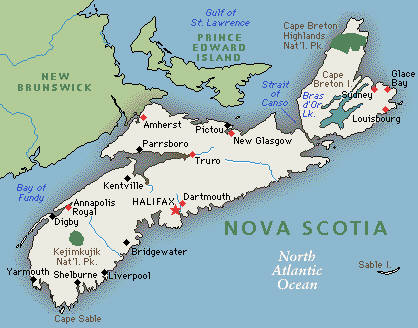The Maritimes:
written by Amy I of MGTC44
in Jan 2010
Nova Scotia, New Brunswick
and Prince Edward Island:
population 1.8 million
The Maritimes has a rich
history and was one of the first North American settlements. When conducting
business “out east”, there are a few things to keep in mind. Here are a
few tid-bits to get you started:
- “Maritimers” have strong
family values and a rich culture. Although very liberal minded, the outward
culture is quite conservative preferring class to sass.
- The residents tend to
appreciate politeness and do not like “big city” brashness.
- East coasters tend to
be good-natured and love to laugh. It is not unusual for you to pass a
stranger on the sidewalk and have them greet you with a smile and a “Hi,
how are ya?” or “Great weather we’re havin’, eh?” As an advertiser, if
you can make them laugh, it’s a good way to win their business.
- Like many places in Canada,
the Maritimes have bitter winters. Because they are on the Atlantic Ocean,
humidity is high and fog is a regular occurrence year-round. Cars
tend to rust very quickly on the east coast due to the combination of the
sea salt in the air and salt on the roads in the winter. Materials
resistant to rust are favoured in this region.
- The geographic location
lends itself to the fishing industry. Although not as prominent as it once
was due to over fishing, lobster is still a well-known “export”.
- Acadia was one of the
first French settlements in Canada. Many Acadians emigrated to the Southern
United States where the name Acadian became Cajun. New Brunswick remains
a bilingual province.
| FOCUS
ON NOVA SCOTIA

|
- Nova Scotia
is Latin meaning “New Scotland” so a great deal of the culture revolves
around the Scottish and Irish traditions.
- Nova Scotia was part of
the Underground Railroad and has a large population of African decent.
- There are many college
age people in Nova Scotia during the school year due to the many renowned
universities including:
o Acadia
o Dalhousie University (Dal)
o University of Kings College
(King’s)
o Nova Scotia College of
Art and Design University (NSCAD)
o St. Mary’s University
(SMU)
o St. Francis Xavier University
(St. FX)
http://www.novascotiaeducation.com/AbsPage.aspx?id=1015&siteid=1&lang=1
- The capital of Nova Scotia,
Halifax, boasts one of the largest ice-free harbours in the world. This
has resulted in several factors including:
• A strong Navy and military
presence which was solidified during WWI & WWII due to it’s accessibility
to enemy ships. (Halifax was victim of one of the largest man made
explosions in the world – please see the Halifax Explosion: http://www.cbc.ca/halifaxexplosion/he1_promise/he1_promise_city_promise.html)
• Large Cargo ships regularly
deliver through Halifax.
• International Cruise Ships
come through Halifax frequently, especially during the summer months.
• Pier 21 – the site of
early immigration to Canada when we all came over on a boat!
- Halifax is home to the
Alexander Keith’s Brewery. Beer tends to be the beverage of choice in Nova
Scotia.
- Not everyone in Nova Scotia
has a noticeable accent however, in Cape Breton, a small island in northern
Nova Scotia, accents can be quite thick and sound similar to Scottish or
Irish. Many famous Canadians came from Cape Breton including comedian Rick
Mercer. |
 |
Nova Scotia is a peninsula
on the Atlantic Ocean boasting miles of beaches and many fresh-water lakes.
water sports are very popular.
(Sailing, surfing, kayaking, canoeing, water skiing, swimming, etc.).
- Because Nova Scotia is
relatively isolated, it has become a popular summer vacation destination
for Canadians and Americans. E.g. Chester, Nova Scotia: http://www.chesterns.com/
|
written by Amy I of MGTC44
in Jan 2010

